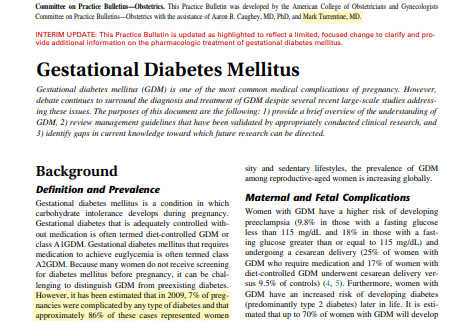GESTATIONAL DIABETES MELLITUS
Gestational diabetes mellitus (GDM) is one of the most common medical complications of pregnancy. However, debate continues to surround the diagnosis and treatment of GDM despite several recent large-scale studies addressing these issues. The purposes of this document are the following:
- provide a brief overview of the understanding of GDM,
- review management guidelines that have been validated by appropriately conducted clinical research, and
- identify gaps in current knowledge toward which future research can be directed.
Background
Definition and Prevalence
Gestational diabetes mellitus is a condition in which carbohydrate intolerance develops during pregnancy. Gestational diabetes that is adequately controlled without medication is often termed diet-controlled GDM or class A1GDM. Gestational diabetes mellitus that requires medication to achieve euglycemia is often termed class A2GDM. Because many women do not receive screening for diabetes mellitus before pregnancy, it can be challenging to distinguish GDM from preexisting diabetes. However, it has been estimated that in 2009, 7% of pregnancies were complicated by any type of diabetes and that approximately 86% of these cases represented women with GDM
- Additionally, the prevalence of GDM varies in direct proportion to the prevalence of type 2 diabetes in a given population or racial or ethnic group. Caucasian women generally have the lowest rates of GDM. There is an increased prevalence of GDM among Hispanic, African American, Native American, and Asian or Pacific Islander women
- Gestational diabetes also increases with the same risk factors seen for type 2 diabetes such as obesity and increased age



